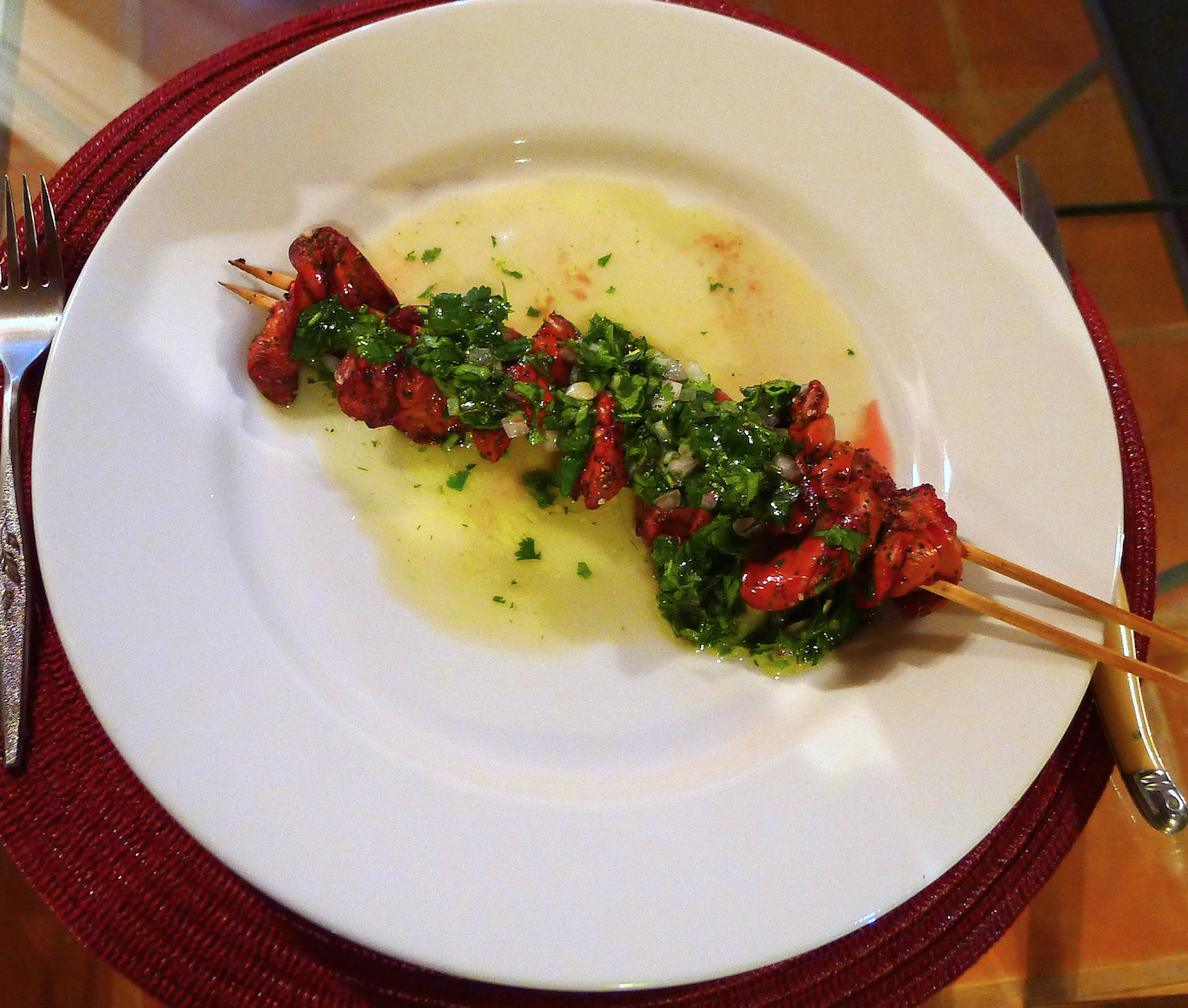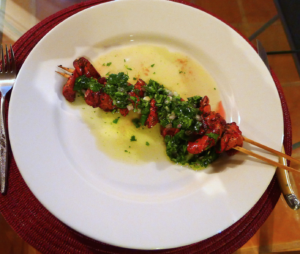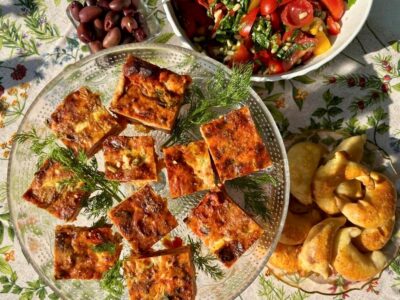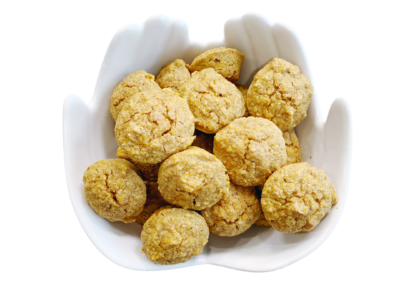The meat we eat was not born in plastic wrap. That may be a spectacularly obvious declaration once a moment’s thought is devoted to the issue. The problem is that most people don’t devote a moment’s thought to the issue. In fact, when they are not actively avoiding thinking about the topic they are inactively doing so.
It is not tough to see why: it’s easier that way. It is disturbing to think that your fillet was once furry and cute and very much alive. To do so is to be complicit in the demise of what you’ve suddenly come to see as an “animal” rather than as “meat.” That’s a lot to deal with on an empty stomach.
If, however, you actually did look your upcoming dinner’s guest of honor in the eye before the meal—and still chose to eat it—how would you actually deal with that? In my case, it did not turn me vegetarian. Rather, I was struck by the notion that since that creature had given its life to feed me I owed it to him to make as little waste of his body as possible; to make use of every last bit of edible meat that I possibly could. Not just the fancy cuts, the celebrated filets, ribs and the other parts with which we are all readily familiar, but the entire beast from nose to tail.
It is a notion that fits rather comfortably in the context of Kabbalah, the Jewish mystical tradition. At the heart of the Kabbalah is the notion that we must reestablish our connection to ein sof, which translates literally as “that which is without limit” and means “The Creator” (or “Nature”). According to Kabbalah, losing our sense of Unity (both with ein sof and with our fellow man) in favor of Egoism—a focus on the self—has been the key source of unhappiness, misery and strife in the world.
The Kabbalistic approach to food is best exemplified by 13th Century Spanish Kabbalist and biblical exegist Bahya ben Asher’s Shulhan Shel Arba (“The Table of Four”). Kabbalists had traditionally seen the soul as being nourished by cognitive focus on The Creator and particular rituals designed to heighten this process. In Shulhan Shel Arba, Bahya taught that just as glimpsing the Creator nourishes the soul, so is the body nourished by food. But Bahya went another step, prescribing rituals and discussions of Torah passages highlighting this parallel, leading to a fusion of the soul’s “eating” (through glimpses of ein sof) and the body’s physical eating. For Bahya, the nourishment the soul receives from the Creator was inseparable from the physical nourishment we receive from food. Essentially, Bahya’s Kabbalistic eating rituals were designed to work a metaphysical transformation.
In many ways, Bahya’s teachings in Shulhan Shel Arba are extensions of the images of Cosmic recycling that in some senses pervade Kabbalah. Indeed, just as spiritual energy is recycled through the entire system (as demonstrated by the Tree of Life and the Sephirot), so is energy recycled through the physical act of consuming food. The energy, the life force, of the creature (or plant) we eat adds to our own energy, our own life force. It follows then that if a part of a creature we slaughter is wasted—not eaten—the remaining portion of that creatures’ life force is lost because it is not recycled.
As Jonathan Brumberg-Krauss has noted in various of his writings on the Shulhan Shel Arba, Bahya is notably vague about precisely what food was on the tables for which he prescribed those Kabbalistic rituals. It is not a stretch, however, to suggest that it might have included more than just the glory cuts. Use of every kosher part of a beast would, indeed, further the contemplative, purposeful eating that was Bahya’s focus.
Bahya might, in that light, have very much approved of this dish of grilled chicken livers, one of the unfancied parts of poultry (which he preferred over red meat). From a purely hedonistic point of view, grilling chicken livers has the distinct benefit of yielding a marvelously caramelized exterior and a luxuriously creamy interior. The acidity (and spice) of the cilantro-lime sauce cuts through the buttery richness of the livers. The “Ash de Mar” garnish is optional, though it adds a certain resonance to the recycling metaphor. Frankly, the presentation recommended below is also optional: the dish works very well with a sauce that is rustic and chopped rather than pureed.
Either way the resulting dish is one worth contemplating. The flavors merit that. The simple magic of the grill and good ingredients merit that. The life sacrificed by the animal merits that. It was, after all, not born in plastic wrap.
Grilled Chicken Livers | Cilantro-Lime Sauce
Ingredients
For the “Ash de Mar” Garnish:
2 cups mixed vegetable matter (such as the peel and trim from the red onion and the cilantro stems from the Cilantro-Lime Sauce, below)
2 tablespoons sea salt
1 tablespoon dulse (optional)
For the Chicken Liver Skewers:
1 pound chicken livers, trimmed
Kosher salt and freshly ground black pepper
For the Cilantro-Lime Sauce:
¼ cup cilantro leaves
½ large red onion, finely chopped
1 tablespoon minced Serrano chile pepper
1/3 cup freshly squeezed lime juice
4 tablespoons light soy sauce
1 tablespoon Worcestershire sauce
2 tablespoons dry sherry
1 anchovy
Directions
- Make the “Ash de Mar” garnish. Preheat the oven to 500° Fahrenheit. Place the vegetable matter in a hotel pan on the highest rack in the oven and cook for an hour or until all the vegetable matter has blackened completely. Transfer the blackened vegetable matter and the sea salt to the bowl of a food processor and process to a homogeneous ash. Strain the ash and allow it to cool.
- Prepare the chicken livers. Soak wooden skewers in hot water for at least an hour prior to use. Prepare and start the grill as necessary and appropriate to your set-up. Thread the livers onto skewers using two skewers for each set of livers. This gives you more control of them during the cooking process. Leave a little bit of space on the skewers between the livers. Season the skewered livers with Kosher salt and freshly ground black pepper.
- Make the Cilantro-Lime sauce. Combine all of the sauce ingredients to the bowl of a Vitamix or other high speed blender (or, failing that, a food processor or other blender) and process until a smooth texture is achieved. If necessary, strain the sauce. Refrigerate the resulting sauce for at least half an hour before using to allow the flavors to fully combine.
- Grill the chicken livers. Grill the livers over moderate heat (indirect heat is best) turning once, until just charred outside and still slightly pink within, about five minutes.
- Plate the dish. Remove the chicken livers from the skewers carefully. Using your hand (there is no better tool) sprinkle of the Ash de Mar garnish at the bottom of the plate. Pour a circular pool of sauce above the line and arrange the chicken livers in a diagonal stripe from the bottom left of the plate to the top right (the number of livers per serving depends on whether the dish is being used as an appetizer or a main course).
Michael Aaron Gardiner is a freelance writer and licensed California attorney living in San Diego. A graduate of Amherst College and the University of Wisconsin School of Law, Gardiner practices business law and litigation during the day and cooks and writes by night. He is also the author of “Kosher Fusion: The Rebirth of a Tradition for the Modern Kitchen,” a book applying the lessons of contemporary, high-end fusion cuisine to traditional Jewish dietary laws in order to forge a new Kosher tradition in the modern Jewish home kitchen. Gardiner is currently looking for a publisher for the book.











[…] of corn tortillas deepens the sense of soul nourishment. It is a sort of nourishment about which I’ve written in this space before, and one that highlights the importance of offal and of the connection of Henderson’s message […]